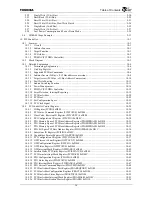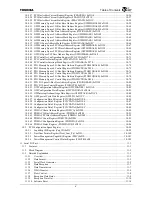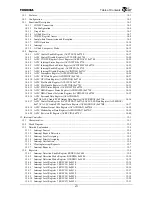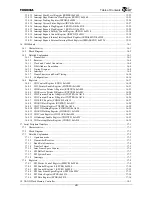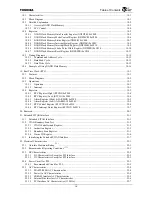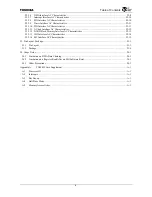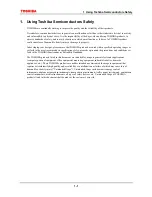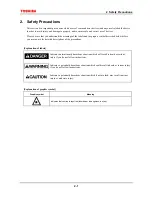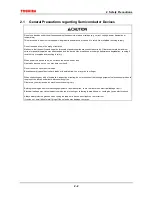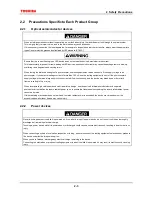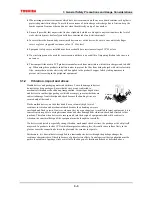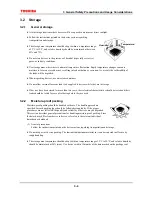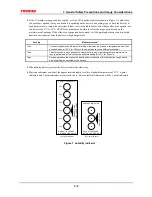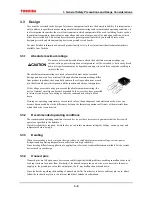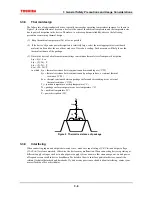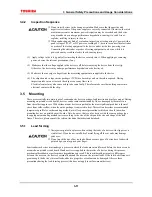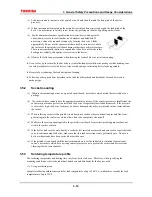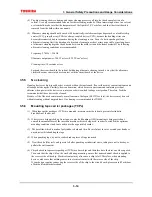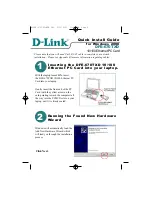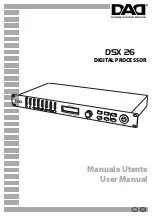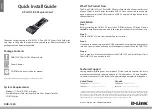
2 Safety Precautions
2-3
2.2
Precautions Specific to Each Product Group
2.2.1 Optical
semiconductor
devices
When a visible semiconductor laser is operating, do not look directly into the laser beam or look through the optical system.
This is highly likely to impair vision, and in the worst case may cause blindness.
If it is necessary to examine the laser apparatus, for example to inspect its optical characteristics, always wear the appropriate
type of laser protective glasses as stipulated by IEC standard IEC825-1.
Ensure that the current flowing in an LED device does not exceed the device’s maximum rated current.
This is particularly important for resin-packaged LED devices, as excessive current may cause the package resin to blow up,
scattering resin fragments and causing injury.
When testing the dielectric strength of a photocoupler, use testing equipment which can shut off the supply voltage to the
photocoupler. If you detect a leakage current of more than 100
µ
A, use the testing equipment to shut off the photocoupler’s
supply voltage; otherwise a large short-circuit current will flow continuously, and the device may break down or burst into
flames, resulting in fire or injury.
When incorporating a visible semiconductor laser into a design, use the device’s internal photodetector or a separate
photodetector to stabilize the laser’s radiant power so as to ensure that laser beams exceeding the laser’s rated radiant power
cannot be emitted.
If this stabilizing mechanism does not work and the rated radiant power is exceeded, the device may break down or the
excessively powerful laser beams may cause injury.
2.2.2 Power
devices
Never touch a power device while it is powered on. Also, after turning off a power device, do not touch it until it has thoroughly
discharged all remaining electrical charge.
Touching a power device while it is powered on or still charged could cause a severe electric shock, resulting in death or serious
injury.
When conducting any kind of evaluation, inspection or testing, be sure to connect the testing equipment’s electrodes or probes to
the device under test before powering it on.
When you have finished, discharge any electrical charge remaining in the device.
Connecting the electrodes or probes of testing equipment to a device while it is powered on may result in electric shock, causing
injury.
Summary of Contents for TMPR4925
Page 1: ...64 Bit TX System RISC TX49 Family TMPR4925 Rev 3 0 ...
Page 4: ......
Page 15: ...Handling Precautions ...
Page 16: ......
Page 18: ...1 Using Toshiba Semiconductors Safely 1 2 ...
Page 40: ...3 General Safety Precautions and Usage Considerations 3 18 ...
Page 42: ...4 Precautions and Usage Considerations 4 2 ...
Page 43: ...TMPR4925 ...
Page 44: ......
Page 54: ...Chapter 1 Features 1 8 ...
Page 58: ...Chapter 2 Block Diagram 2 4 ...
Page 88: ...Chapter 4 Address Mapping 4 12 ...
Page 226: ...Chapter 8 DMA Controller 8 58 ...
Page 260: ...Chapter 9 SDRAM Controller 9 34 ...
Page 480: ...Chapter 15 Interrupt Controller 15 32 ...
Page 554: ...Chapter 19 Real Time Clock RTC 19 8 ...
Page 555: ...Chapter 20 Removed 20 1 20 Removed ...
Page 556: ...Chapter 20 Removed 20 2 ...
Page 564: ...Chapter 21 Extended EJTAG Interface 21 8 ...
Page 580: ...Chapter 22 Electrical Characteristics 22 16 ...
Page 588: ...Chapter 24 Usage Notes 24 2 ...


